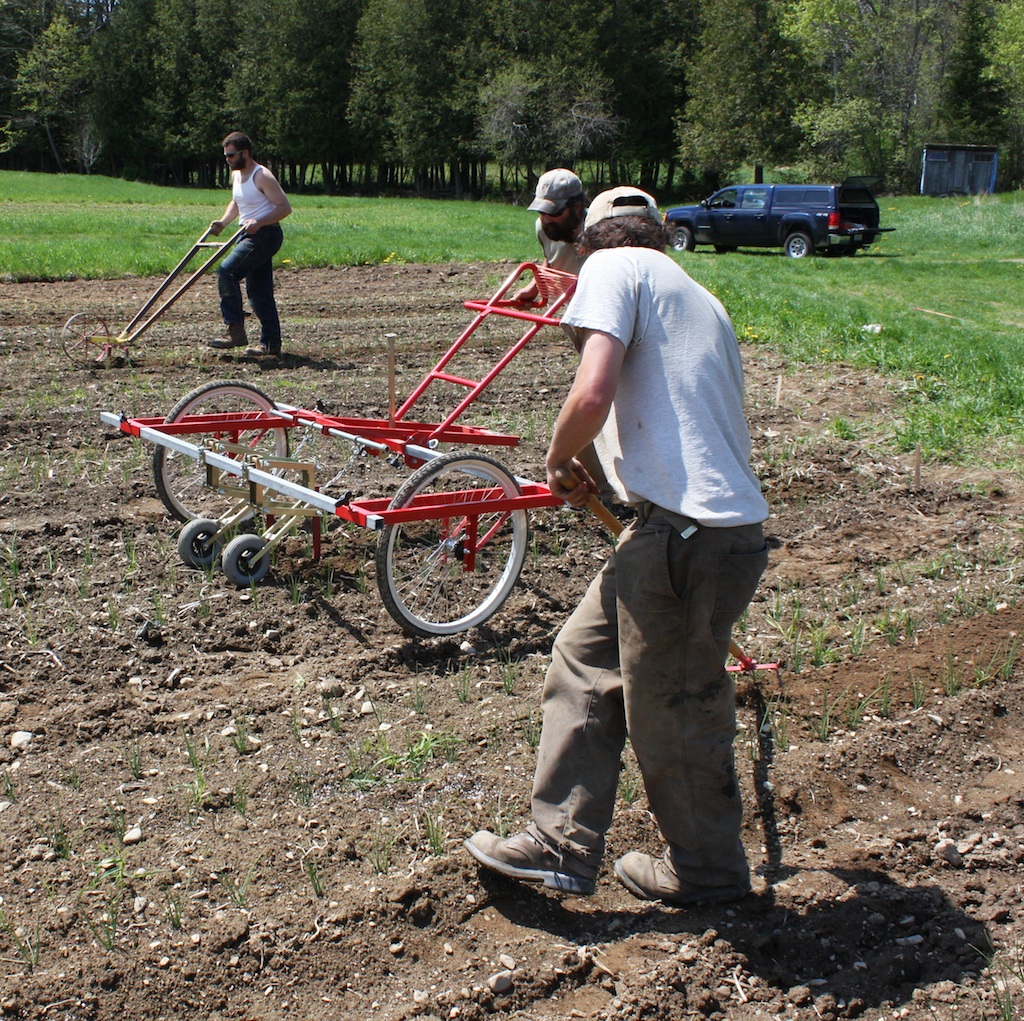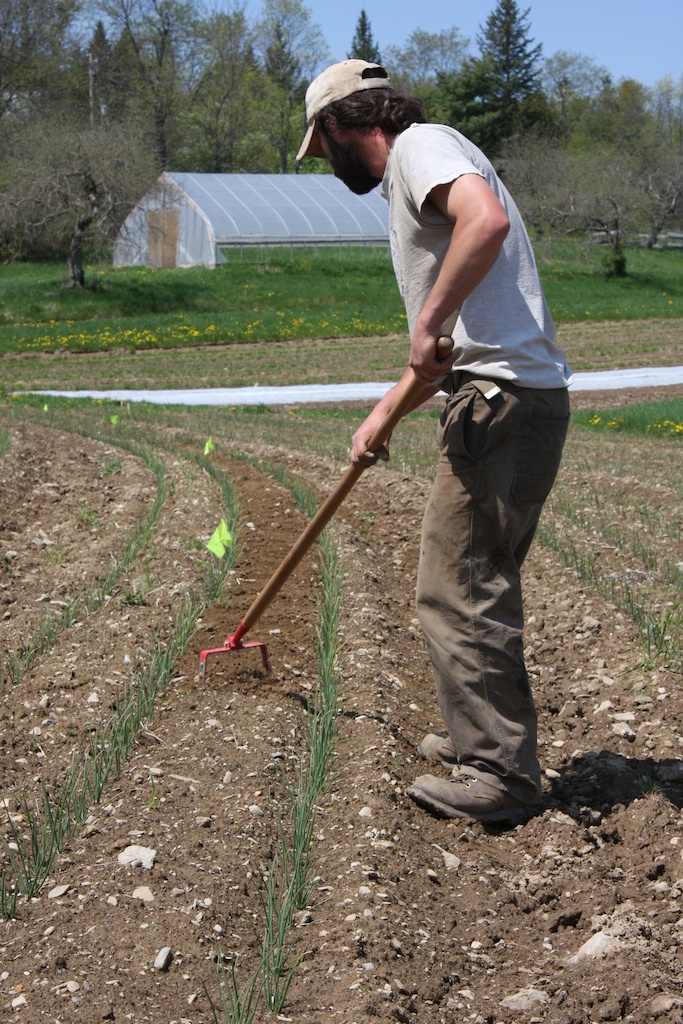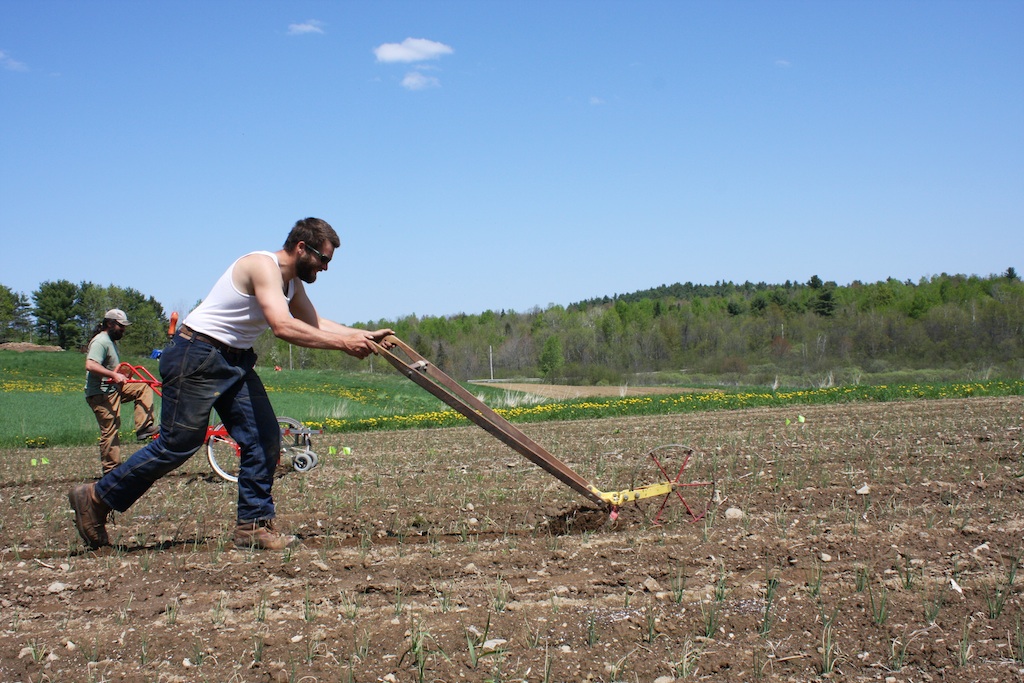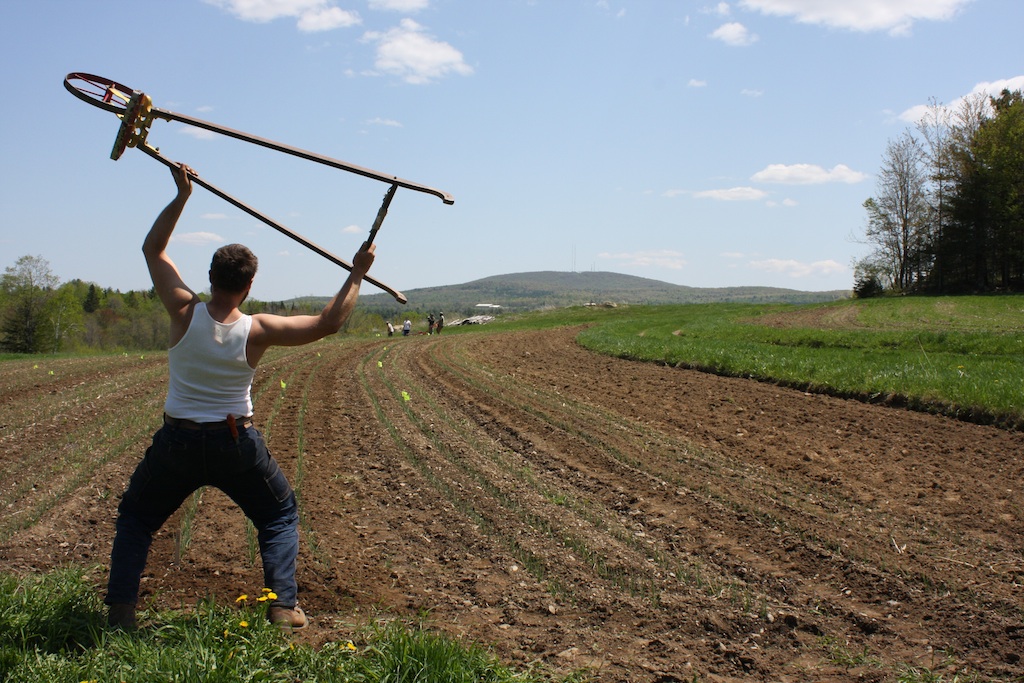Weed Master vs. “The Pig” vs. “Scuffles”
13 May 2009
It was a very exciting day comparing the Weed Master to tried-and-true cultivation tools at the Peacemeal Farm. Depending on conditions, the crew would use a favorite old steel-wheeled hoe with a wide stirrup, “The Pig,” and/or scuffle hoes. We decided to compare the Weed Master, with sweeps or finger weeders, to these typical tools, looking at both efficacy (proportion of weed seedlings killed), and working speed.

One bed of onions each in a timed event with pre- and post-emergence efficacy measured in four randomly located 1/16th square meter quadrats. The contoured, 216 ft. long beds contained three rows of transplanted onions on 15 in. centers; onions were 4 to 6 in. tall at the time of the trial. Post-cultivation censuses of weeds was performed the following day.
The stirrup hoe was a 7 in. wide model commonly available through garden suppliers (e.g., Johnny’s Selected Seeds). The operator, Tim, is a highly-regarded by farm members as an expert with the stirrup or “scuffel” hoe, and has several seasons of experience.

“The Pig,” as it is affectionately known on the Peacemeal Farm, is a wheel hoe that is no longer commercially available. A copy of the Planet Jr No. 17 that was reproduced by Red Pig tools, now in Oregon. Although not presently available, Rita Denman of Red Pig Tools indicated that they have plans to reintroduce “Red Pig No. 1,” which they hope will be available in the spring of 2010. Two notable features of this tool offer superior performance to currently-available options. First, the steel wheel does not bounce over stones or other obstructions, a problem with the pneumatic tires of, for example, the Glaser® wheel hoe. Secondly, the Peacemeal team likes the heavy cast frame assembly of The Pig.
Time. Considering only the working time, the Weed Master was the clear winner. With the finger weeders it took 7 min. 10 sec. to weed the three rows of onions in the 216 ft. bed; with sweeps, 10 min. 20 sec. This compares to 13 min. 58 sec. for The Pig and 29 min. 6 sec. for the scuffle hoe.
However, the Weed Master can only weed one row at a time and we could not set up the parallel linkages in one location on the tool bar that would be suitable for both the center and the outside rows. Mark started with the linkages adjusted for the center row, but at the end of this pass he had to move them to the side to cultivate the outside rows. Thus, if we add this “fiddling time” with the working time and considering total time, the Weed Master w/finger weeders barely inched out a victory over The Pig: 13 min. 16 sec. total for the Weed Master w/finger weeders vs. 13 min. 58 sec. for The Pig. The scuffle hoe and The Pig had no need for such adjustments. Total time for the Weed Master w/sweeps was similar at 14 min. 30 sec.
Efficacy. Were the tools similarly effective at killing weeds? Generally yes. We measured the proportion of weeds killed (mortality, from 0, none killed, to 1, all killed), both between the crop rows and within the crop rows. As expected, each of the tools did a fine job killing between-row weeds, with mortality ranging from 80 to nearly 100% (see figure, below). The means and variation within the treatments were remarkable similar; the overall mean of all treatments was 89%.

Control of the within-row weeds was more consistent with The Pig, which was unexpected. I would have considered the flexibility of the scuffle hoe and the consistent working action of the finger weeders to have offered more consistent results. Overall, control of in-row weeds was, as expected, less than control of between-row weeds; overall mortality of in-row weeds averaged 50%. There is some evidence that The Pig outperformed the other tools based on this criterion. Mean proportion of weeds controlled and variation were similar for the other tools. Note that this field evaluation, although multiple samples were measured for each treatment, they represent subsamples, not true replication.

Tim, “Scuffles,” bed was quite attractive in it complete lack of foot prints within the bed. In using The Pig, Mike used a technique to minimize the number of foot prints between the rows while maximizing speed and control: “large step, lunge with body and arms.”

Despite the slow working time of the scuffle hoe the quality of this weeding job was outstanding. The scuffle hoe, in the hands of an experienced user, is unparalleled in ability to immediately adjust to variations in soil conditions, crop, or weed size (e.g., to make passes more or less aggressive as needed).
Overall I am most impressed to date with the finger weeders. Early in the day, when soil conditions were moist their working action was not impressive. However, later in the day, as the soil dried to nearly perfect cultivating conditions, I adjusted the yellow fingers to a 1 in. gap and did a final bed, first the center row, and then adjusting the linkages to and pushing handle to the side for the outside rows. Keeping up a rather quick walking speed, the fingers did a very thorough job of disturbing or throwing soil in the row, between the onion plants. The working width of fingers was about 6 in. on either side of the row, so the passes on the outside rows mostly obliterated the footprints from my center row pass, and the working speed, although not timed, was quite fast.
Weed Master
The pushing handle section of the Weed Master has proven difficult to keep in a lowered adjustment. There does not seem to be sufficient friction with the carriage bolts to hold the handle against the force of the user pushing. The handle then slowly moves up to the maximal height. This will be a problem for uses who wish to have the handle lower. Perhaps a pin/hole design could index the handle into a range of positions.
Under challenging conditions, e.g., up hill or on uneven ground, pushing the Weed Master is physically demanding, perhaps due the weight of the tool, and the effort to keep it centered on the row being cultivated.


